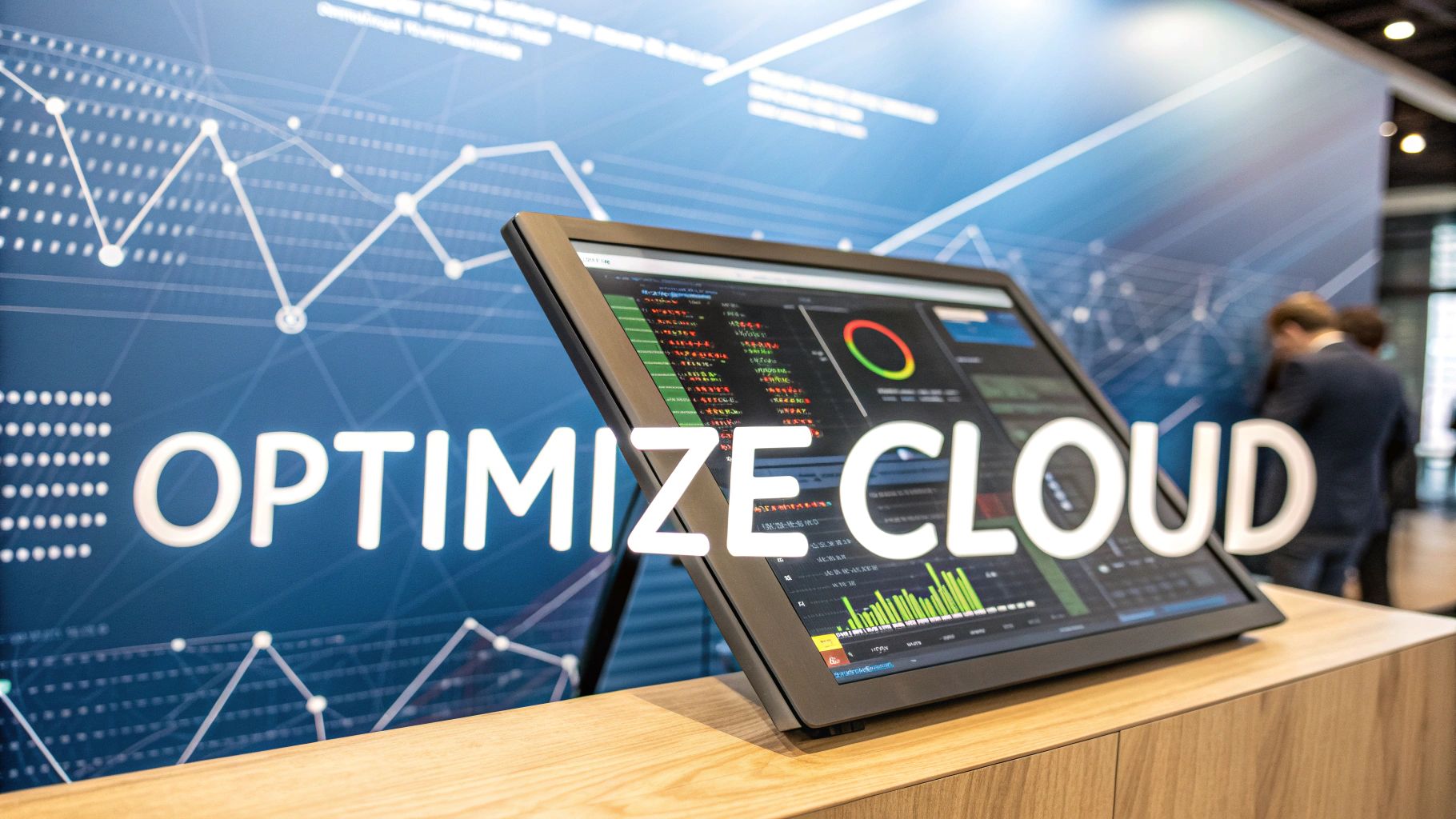Cloud Cost Optimization: 6 Proven Strategies to Reduce Your Cloud Spend
Understanding the Cloud Cost Crisis

Many organizations are struggling with rapidly rising cloud costs as they try to scale their infrastructure while keeping expenses in check. This cloud cost crisis has become a major challenge for IT teams who need to balance innovation and growth with responsible spending. Cloud expenses now make up a significant portion of technology budgets, requiring new approaches to financial planning and cost control.
The Growing Scale of Cloud Spending
The numbers paint a clear picture of surging cloud adoption and costs. Global spending on public cloud services reached $563.6 billion in 2023 and is expected to grow to $678.8 billion in 2024. Despite this massive investment, most companies still struggle with cost management – only 22% of organizations have successfully allocated most of their cloud spending, while 78% continue facing challenges with budget control. Learn more about cloud spending trends.
Key Factors Driving Cost Increases
Several common issues often lead to rising cloud costs:
- Wasted Resources: Many companies pay for idle or unused cloud services they've forgotten about
- Old Systems: Running outdated applications in the cloud often costs more than modernizing them
- Poor Cost Tracking: Without clear visibility into cloud usage patterns, costs can spiral quickly
Taking Control Through Better Planning
Smart companies are getting ahead of cloud costs through practical steps like:
- Smart Automation: Using tools that automatically scale cloud resources up and down based on actual needs
- Clear Rules: Setting specific policies about cloud usage and spending across teams
- Usage Monitoring: Tracking detailed metrics to understand exactly where money is being spent
Getting cloud costs under control requires both better tools and better practices. Companies need to invest in proper training for their teams while also putting the right systems in place to track and manage spending. With a thoughtful approach to cloud cost management, organizations can continue innovating while keeping their budgets healthy.
The Rising Challenge of Cloud Cost Management
Managing cloud costs has become increasingly complex for businesses, especially with the shift to multi-cloud environments. Basic cost reduction methods that worked well in the past no longer deliver the same results. Industry experts have found that using multiple cloud providers creates new hurdles around tracking, managing, and controlling spending across platforms.
Why Traditional Methods Fall Short
Companies used to rely on simple tactics like reducing server instances or storage to cut costs. But in multi-cloud setups, these approaches don't address the full scope of the challenge. Internal organizational barriers create additional complexity – different teams often use their preferred cloud providers, making it difficult to monitor and optimize costs effectively. Success requires a coordinated effort across the entire organization.
Overcoming Resource Allocation Challenges
Leading organizations have found success by taking a structured approach:
- Creating clear governance frameworks to align cloud usage across departments and ensure efficient resource allocation
- Implementing dedicated FinOps tools designed specifically for cloud cost management and optimization. Recent research from Flexera found that 82% of companies struggle with cloud cost control, but businesses have achieved 45% savings through proactive resource management and eliminating waste. Learn more about cloud cost trends.
Emerging Approaches
Organizations are adopting new strategies to handle expanding cloud environments more effectively. The FinOps methodology has proven particularly useful by:
- Defining clear usage guidelines for teams
- Deploying automated tracking systems for real-time cost visibility
- Building bridges between finance and IT departments to balance budgets with technical needs
By addressing these challenges head-on and embracing proven methods, companies can build more effective cloud cost management practices. Getting cloud expenses under control isn't just about savings – it's essential for maintaining healthy margins and growth.
Small Business Impact and Optimization Strategies
Cloud services now make up a significant portion of technology spending for small and medium businesses. Recent data shows that SMEs allocated 47% of their tech budgets to cloud services in 2022 – a 67% increase from the previous year. This growth highlights why smart cloud cost management matters more than ever. By the end of 2023, cloud spending is expected to account for more than 50% of SMEs' total tech investments. Get more details about cloud spending patterns.
Practical Approaches for SMEs
Small businesses can take several straightforward steps to keep cloud costs in check while supporting their growth:
- Quick Cost Savings: Look for easy wins first – remove unused resources and set up automatic scaling to match actual usage needs
- Simple Monitoring: Pick basic tools that show spending patterns and flag unusual spikes in usage
- Team Buy-in: Help employees understand how their cloud usage impacts costs and make smart choices
Actionable Frameworks for SMEs
Here's how small businesses can put cloud cost management into practice:
-
Resource Planning:
- Use built-in tools to match resource size to actual needs
- Check regularly for services you're paying for but not using
-
Budget Control:
- Create clear spending limits based on past usage patterns
- Watch costs in real-time to catch and fix issues early
-
Smart Growth Plans:
- Break applications into smaller pieces for better control
- Lock in lower rates with reserved instances for predictable workloads
By following these practical steps, small businesses can trim unnecessary cloud spending while keeping the technology they need to grow. The key is making small, consistent improvements that add up to real savings over time.
Implementing FinOps Best Practices
Building strong cloud cost management starts with bringing together your finance and technology teams effectively. The key is establishing dedicated teams who deeply understand both the technical and financial sides of cloud spending. This collaborative approach helps organizations find smart ways to optimize their cloud costs without sacrificing performance.
Structuring Effective FinOps Teams
When building FinOps teams, include people from both finance and technology backgrounds who can work together smoothly. Your teams should focus on:
- Building financial awareness: Teaching all team members how their technical choices affect cloud costs
- Creating clear cost tracking: Making cloud spending visible and easy to understand for decision-makers
- Improving team communication: Getting different departments talking about shared cost-saving goals
The real power comes from making everyone in your organization think about cloud costs. When each department takes responsibility for their spending, you'll see bigger and more consistent savings.
Selecting and Utilizing the Right FinOps Tools
Good tools make a huge difference in managing cloud costs well. Look for tools that offer:
- Live cost tracking to see exactly what you're spending in real-time
- Smart alerts that catch unusual spending before it becomes a problem
- Detailed reports to help you make better decisions about cloud investments
For example, tools with AI-powered monitoring can spot cost spikes quickly and help prevent budget surprises.
Overcoming Implementation Challenges
Starting FinOps isn't always easy. Teams might resist changes, and some tools have limitations. Here's what helps:
- Training your teams: Teaching everyone both the money and tech sides of cloud management
- Setting clear goals: Making sure everyone knows exactly what you're trying to achieve with cost management
Success comes down to getting finance and tech teams working together well, using solid tools, and building a culture where everyone cares about costs. When you do this right, you'll not only save money but also run your cloud services more efficiently.
Advanced Cost Optimization Techniques
Getting the most value from your cloud spending requires going beyond basic cost management. Let's explore some advanced strategies that can help you take control of cloud costs and maximize your investment.
Automated Scaling Solutions
Automated scaling helps you match cloud resources to actual demand in real-time. When traffic spikes, your infrastructure automatically expands to maintain performance. During quiet periods, it scales back down to avoid waste. For instance, an e-commerce site might scale up servers during holiday shopping rushes, then reduce capacity overnight when fewer customers are browsing.
Advanced Reserved Instance Management
Reserved Instances (RIs) can cut costs significantly compared to on-demand pricing, but they need careful planning. Smart RI management starts with analyzing your usage history to forecast future needs. Based on this data, you can select the optimal RI types, terms, and payment options. Regular reviews ensure your RI portfolio keeps pace with changing requirements.
Intelligent Spot Instance Utilization
Spot Instances give you access to spare cloud capacity at major discounts, though they can be interrupted on short notice. The key is identifying workloads that can handle interruptions – like batch processing jobs, test environments, or applications with built-in fault tolerance. With the right workload selection and fallback plans, spot instances can deliver substantial savings.
Leveraging Tools and Technologies
The right tools make a big difference in controlling cloud costs. Cloud management platforms give you clear visibility into spending and can automatically optimize resources. For example, they might right-size underused instances or shut down idle services. Cost anomaly detection tools use AI to spot unusual spending patterns early, letting you address issues before they impact your budget. When used together, these tools help create an efficient, cost-effective cloud environment that delivers real business value.
Measuring Success and Maintaining Optimization
Putting cloud cost optimization strategies in place is only the beginning. To keep those savings going and show real business impact, you need solid measurement systems and ongoing refinement. This starts with defining clear Key Performance Indicators (KPIs) and building reporting that drives action.
Key Performance Indicators for Cloud Cost Optimization
To understand if your cost optimization efforts are working, focus on these essential metrics:
- Total Cloud Spend: Look at your complete cloud costs over time – monthly, quarterly, and yearly. This basic but crucial number helps spot trends and measure your progress.
- Cost Per Unit: Break down spend into meaningful business metrics like cost per customer or transaction. This shows how efficiently you're using cloud resources to deliver value.
- Resource Waste: Track unused or idle resources as a percentage of total spend. Things like orphaned storage volumes need quick cleanup to stop unnecessary costs.
- Reserved Instance Usage: For teams using RIs, monitor utilization rates closely. Low usage means you're not getting full value from your commitments.
- Prevented Costs: Measure savings from catching and fixing potential overspending before it happens. This shows the value of proactive management.
Reporting Frameworks and Stakeholder Communication
Good reporting helps everyone understand the impact of cost optimization work:
- Set a Schedule: Share updates with stakeholders at regular intervals – monthly or quarterly works well for most teams.
- Use Clear Visuals: Make data easy to grasp with simple charts showing key trends.
- Connect to Business Goals: Show how savings contribute to company objectives like increased profits or new initiatives.
Maintaining Optimization Gains and Continuous Improvement
Cloud cost management needs ongoing attention to succeed. Here's how to keep momentum:
- Regular Check-ins: Review your strategies and metrics periodically to confirm they still make sense.
- Automate Where Possible: Set up automated resource sizing, cleanup of idle resources, and reporting.
- Assign Clear Ownership: Make sure specific people are responsible for managing cloud costs.
- Build Cost Awareness: Help everyone understand why cloud costs matter and how they can help control them.
When you track the right metrics and create shared responsibility for costs, cloud optimization becomes a lasting advantage rather than a one-time project.
Want to better understand and control your cloud spending? DebugBar.com offers helpful resources on technology, digital topics, and marketing, including articles on IT performance optimization. Check out DebugBar.com to learn more.


